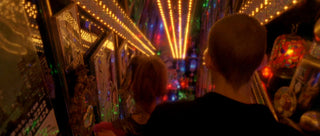You don’t watch Gaspar Noe movies, you subject yourself to Gaspar Noe movies.
Noe has zero interest in traditional blockbuster storytelling. He walked out of Black Panther after twenty minutes. He hates Star Wars. And when you watch one of his films, you understand why: Gaspar Noe is not happy unless he’s making you uncomfortable.
He doesn’t just shock, and this is why he’s a valuable director: yes, shock is there, but Gaspar Noe movies unsettle through emotional and intellectual experience. They make us feel things through their structure, with the stories they choose to tell and the juxtapositions they make, things we couldn’t feel any other way.
In Enter The Void, our protagonist dies early, shot by Tokyo police during a drug deal gone south. He was snitched on by a friend; the deal was a sting. His assassination is shocking and violent, and there’s also the narrative shock that our “hero” is dead so soon—no less because the film is happening in first person, from his point of view. We look down to see a bullet hole in our own chests as our vision blurs and our heads swim along with the camera.
But this shock immediately gives way to an idea, a structure: we slowly learn that we’re to spend the rest of the movie circling around that moment and trying to understand it. The structure is a loop, and it’s going to force us to look at the loops in our own lives—the biological ones, the technological ones, maybe the good ones but definitely the bad ones.
Our main character did not wind up in that drug deal at random, nor was his friend’s betrayal out of nowhere. Everything started when he was a child, all the mechanisms were sent in motion then, and despite his big ideas about traveling to Tokyo, doing drugs, then dealing drugs, all thereby achieving freedom, he never really escapes his own cycles.
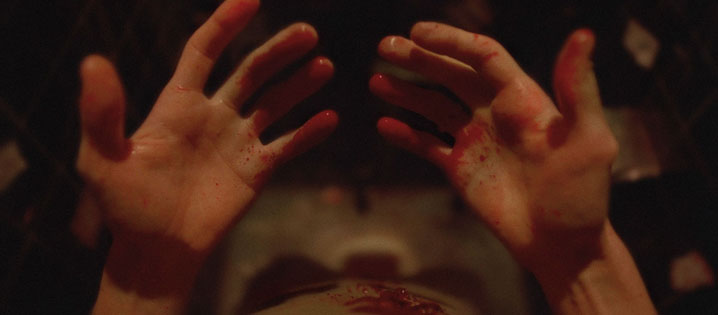
Photo: kinoimages.wordpress.com
The unsettling thing is that through sheer, bloody hammering-home of this idea, Enter The Void makes us wonder if this isn’t true for all of us. We follow our desires because we think they lead to freedom, but in the end, they just lead in a circle.
Our first-person main character’s name is Oscar. His friend Victor snitched on him because the police threatened to jail Victor otherwise, but also because our main character fucked Victor’s mom. Yes, his mom. She seduced him originally, but he kept pawing after her because he has Freudian issues leftover from his own parents’ violent death in a car accident, right in front of him, and from witnessing their primal scene through an open doorway when he was just a child.
These same Freudian issues make Oscar aggressively protective of his own sister, and overly—almost sexually—intimate with her. This possessiveness interferes with maybe his one decent friendship, with the bohemian Alex, while in Tokyo, because Alex likes her too. Our main character’s whole romantic life, and also his sense of meaning and human connection, are excessively bound up with his sister, her life, and her status as blood-family in connection with his dead parents.

We follow our desires because we think they lead to freedom, but in the end, they just lead in a circle.
He seems to see his sister as a link to a sort of childhood purity. The way he watches her and judges her behavior throughout the film, and the contrast between the present circumstances and his idyllic flashbacks of her, reek of old-school patriarchal obsession with “unspoiled” femininity. Oscar seems fixated on her role in his life and on her sexual behavior (as does Gaspar Noe). So while she slides into the deep end of the Tokyo underworld via sex work, and eventually winds up romantically involved with (and pregnant by) the owner of her strip club, Oscar spirals further and further into alienation from her and all his friends.
You with me so far? Yeah, welcome to Gaspar Noe land. Sorry if you were in, like, a good mood when you started reading this.
Here, we have to talk about the film’s misogyny, because it’s pretty undeniable. It’s very difficult to separate Oscar’s view of women from Gaspar Noe’s view of women. On the one hand, we’re seeing everything through Oscar’s eyes. We could argue that Noe is saying something about Oscar, and about male myopia in general—not about women, who they are or who they should be. The film is a literal exercise in male gaze.
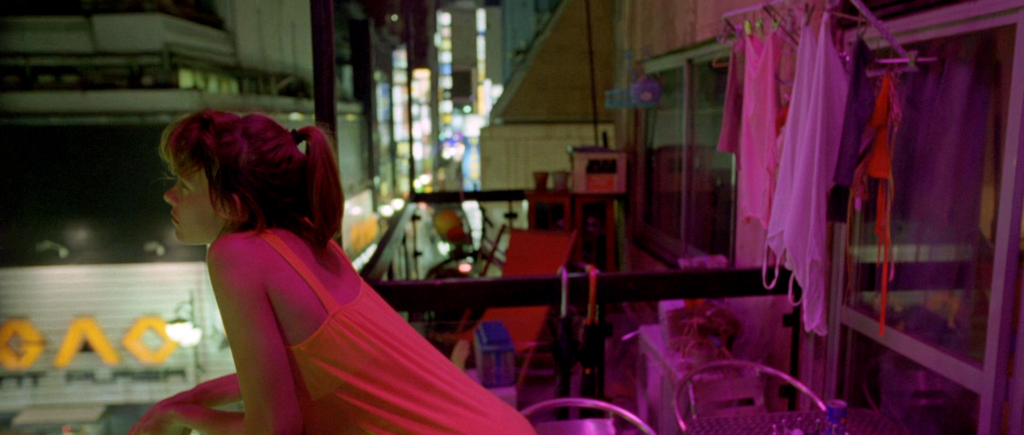
On the other hand, Noe is the one who chooses to linger on female nudity voyeuristically, to focus the camera on environments like strip clubs, and he seems deeply invested in the connection between the female characters’ bodies and “the biological.” Pregnancy, abortion, sex, nursing, birth, motherhood—the women in the film are constantly and aggressively linked by the filmmaker to reproduction, objectification, and their sexual and maternal viability vis-à-vis the men that surround them. We see no evidence that any male in the film has female friends, or that they relate to women in any way beyond this crude facsimile of animal need.
So Noe’s perspective doesn’t feel less one-note just because he’s making a point about male perspective and male desperation. Maybe the best that can be said of Noe is that he shows us the limits of his own—and of Oscar’s—thinking. Because on the part of the main character, this obsession with the sexual and maternal dimensions of the feminine leads nowhere good. It leads to a knot of desperate emotional drama, and then eventually to his death.
The film is a literal exercise in male gaze.
But at least we do see this problem. Noe shows us. We watch the impact of these obsessions, these fears, these toxic preoccupations on Oscar and the people around him. We see his cycles clearly, and we see how his reactions and his desperate seeking of comfort and freedom led to disaster.
Lest you worry we’re reading too much into things, Alex spells this idea out for us explicitly at the beginning of the movie when he gives Oscar the Tibetan Book of the Dead as a gift. The Book of the Dead is a popular interpretation of Tibetan Buddhism that concerns itself with the Bardo, the limbo after death but before reincarnation, where we confront all our bad karma, terrible decisions, and unskillful reckonings with desire. Unbound from our body, we hallucinate vividly about all our spiritual failures as we try to get free, toward enlightenment. We’re watching this process, for Oscar, in real time.
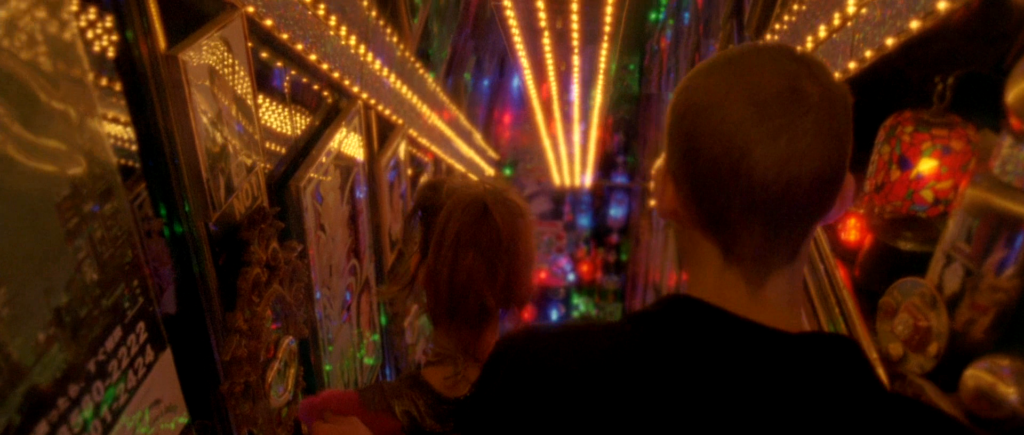
The movie is divided into a series of vignettes, scenes that illustrate various consequences of Oscar’s actions. Between every vignette, there’s a bizarre sequence where we zoom out into a pulsing, distorted fisheye that turns the whole scene into a globe of tension and secret malice. Then we zoom in through a round hole: whatever’s available—sometimes an ashtray, sometimes a light fixture, one time an aborted fetus. The movie continues to gesture toward Freud by drawing our attention to the relationship between these holes, the gateway of the womb, and the abyss of death.
Between each scene, when we zoom out, when the room pulses and becomes fish-eyed and ghostly—that’s when we’re in the Bardo. The humans of the film are lost in its surreal landscape, and it doesn’t take long for that pulsing cycle to become more real than they are. It happens over and over, as the characters drift, fade, die, and are reborn.
The in-between places. That’s where the answer is. The cast, chasing their small dreams, start to look like slaves of their instincts. There’s a desperate, searching quality to their movements, a sort of vulnerability and smallness we see in their search for a warm set of arms to curl up in. Their needs become precious, and ultimately smaller that that cycle, that big, eternal life-death pulse, revealed to Oscar by the DMT he smokes at the opening of the film, and experienced by the audience again and again.

This talk of cycles probably sounds familiar to the reader. All of us, I imagine, have days where we wonder if we’re caught in a loop. This workday resembles yesterday’s so closely that we start feeling trapped. This love affair seems to play out as mirror image of the last one. We get high, we come down. We remember the last time we masturbated as we pull off our pants, and it all starts to get a bit dull.
Our smartphones focus this experience into the space of seconds, where we check, re-check, and double-check our various inboxes and social platforms so rapidly that it becomes clear that we’re engaging directly with our brain’s own dopaminergic mechanism more than we’re engaging with any kind of external culture.
Our unspoken assumption is that we must find comfort, that we must seek out new forms of stimulation or emotional closure to escape our daily grind, that desperate feeling of lab-rat-pushing-a-lever numbness. But when we look around at the global economy, we see this seeking is precisely what produces our prison. What if, instead, we were to move toward the empty space? To the moments between the thoughts, between our second-to-second spasms of desire?
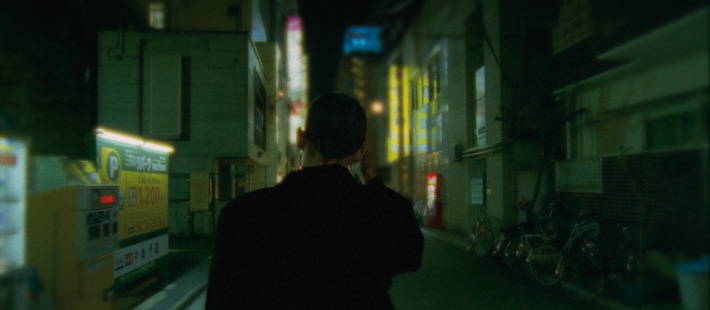
Photo: kinoimages.wordpress.com
This is precisely why Gasper Noe has such disdain for traditional narrative. Blockbuster films are all about that simple arc of desire, which is why we love them so much. A conflict is set up, and then neatly resolved. Desire, then satisfaction, like a two-hour buildup to orgasm. Despite his pubescent fixations, Noe has the perspective to see that that kind of masturbation always leaves you lonely in the end, with a vague sense that something else should happen next, that some other form of completion waits just over the horizon.
Enter The Void. The title of the film isn’t just catchy, it’s a literal instruction. In Buddhism, the death of desire—the ultimate dissolution of the individual into Nirvana—is the goal. We’re so used to thinking of hedonistic goals that a fundamentally Buddhist film structure is baffling. We want desire to be satisfied, and then we want the credits to roll. But that’s not the point. The point is to see the cycle, to appreciate it for what it is, and to move beyond it.
***

